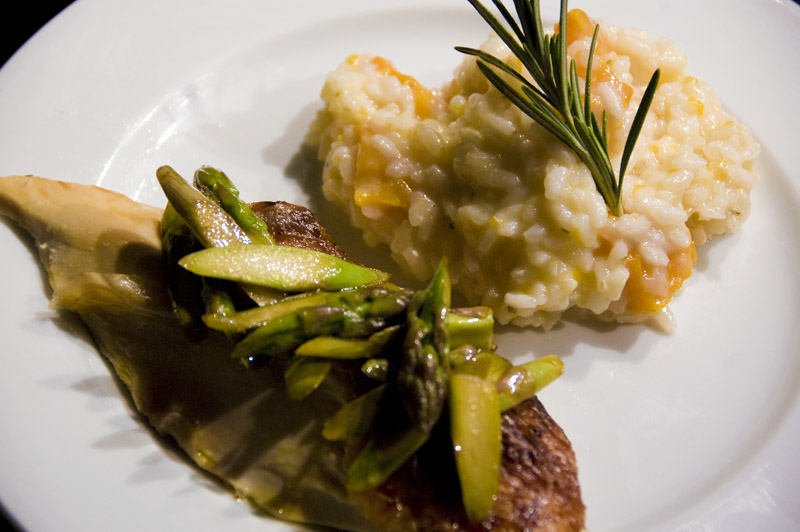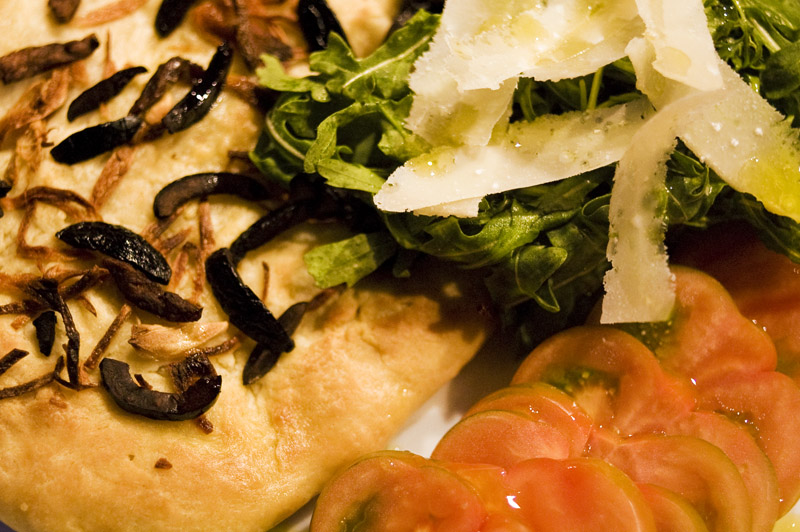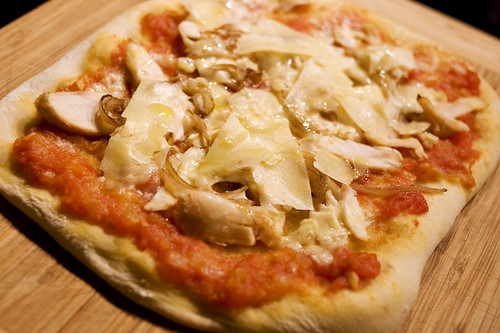Alannah and I used to have Sunday "date nights" which usually involved a movie of some sort and a long, languid three-courser at our local Italian joint in San Francisco. It was cheap. It was a chain. But it was good. Now, being denied all that, I whip up a meal that might be date-worthy, and we download something to watch on BitTorrent.
 |
| Roast chicken breast with pan-fried asparagus slivers, butternut squash & rosemary risotto |
Extra motivation was provided when cousins from the US told us they're going to Italy this summer, and that we should join them, renting a house in Umbria or Tuscany. Alannah started fantasizing about making like Diane Lane in Under the Tuscan Sun, lolling about on the terrace as we put away bottles of Chianti and Brunello di Montalcino. I started fantasizing about making it with Diane Lane. (Umm, hello, she might be old, but have you *seen* Unfaithful??) The best part would be having our own kitchen, meaning we could stock up on local ingredients and avoid being ripped off at restaurants.
So the last few weeks have involved a lot of experimentation. Some of it in the kitchen, trying out a marathon of Italian "basics" so we can treat our US brethren to our cooking without looking like back-assward Parisians, scaring the kids with our salacious organs. (You know, kidneys, livers and the kind.)
Yes, there will be kids with us, so our adventures in Italy will be strictly rated PG. Or "-10" as they say here in France.
And kids like spaghetti. I like spaghetti. Just about every idiot knows how to make spaghetti.
 |
| Spaghetti pomodoro-basilico |
Flipping channels one night, we found some Canadian show about some guy who goes around Italy cooking outdoors. I have no idea what it's called, nor who the guy is. It's all dubbed in French. All I know is that he keeps it really simple, picking up local ingredients and doing very little to them. But I found myself drooling. "This," I declared to Alannah as I leaned over to her on the couch, "is how I want to do it in Italy." We subsequently talked about food.
 |
| Foccacia. Arugula with Parmesan. Heirloom tomatoes. That's it. |
Next most complicated: Arugula salad. Or roquette or rocket or whatever you call it in your neck of the woods. Toss that salad. (With salt.) Shave that smelly thing. (Parmesan cheese.) Serve drizzled with olive oil.
Next on the list: Sliced heirloom tomatoes. Sprinkle a tiny bit of salt. That's it. Oh yeah, serve drizzled with olive oil.
See a pattern there? Take simple ingredients, and give it a money shot with really fucking good olive oil.
Of course, one can't sit on the terrazza, sipping wine and nibbling antipasti all afternoon while the munchkins slurp spaghetti. When the sun goes down, we may feel the need for something hotter.
 |
| Pizza bianca with tuna, sweet onion, and lemon zest. Drizzled with olive oil. |
There are a gazillion varieties of pizza, obviously, but the key rule is to not overload it with toppings. When you're putting shit like white wine or sake into your dough, you kinda want to, you know, taste it.
You also want to taste your sauce. Especially if you've made it from scratch. And the best way to do that is to follow the tomato sauce recipe above for the spaghetti, and then pour that over sautéed onions and garlic and simmer. Done. You can also go a totally different way and spew white stuff all over your pizza dough.
For the first time, we made a pizza bianca (white pizza) - where instead of tomato sauce, we used crème fraîche. You can top a white pizza with anything, but just remember that if you use a seafood topping, the rule is: No cheese. There are a few exceptions here and there, but generally speaking, no one wants to snack on your tuna with a side of curdly cheese, mmkay?
 |
| Roast chicken with aged white cheddar and caramelized onions. |
Is it authentic Italian? Hell no. But making fresh bread and sauce to mop up and not waste what food you already have is totally in the paisan spirit.
A few nights ago, we had half a red bell pepper sitting around and getting ready to shrivel, so we sliced it up and threw it on a pie with mozzarella di buffula, caramelized onions and diced garlic, and it turned out to be the most cream-in-your-jeans delicious vegetarian pizza we've ever had.
Pizza dough also keeps really well: You can roll it up into balls and freeze it long term, or store it as a wad, in a sealed container in the fridge for a few days. So it's super easy to come home and throw a pie together after a long day of prostituting your ass out to whatever corporation you work for. In short, even a butt-whore can make good pizza. Providing s/he has a very hot oven.
In our fit of Italian experimentation and ridding ourselves of leftovers, we came to one of the most amazing dishes ever: Smoked herring carbonara.
 |
| Smoked herring. No cheese. Duh. |
The garnish is important, believe it or not. Personally, we've gotten into young garlic stem or ramps sliced up like chives or scallions. They taste more garlicky and have more crunch. But being that you can't always come by young garlic (or allium or ramps) any member of the green onion or chive family will do. Slightly greening up your carbonara that way will bring it to life and add more depth to the simple, delicious flavors already within. And that's what this cuisine is all about.
Come summertime, we'll send you an update how it goes in our Tuscan kitchen.
In the meantime, any Italians reading this, please feel free to correct any of our bullshit. We know that's the only way to con you into divulging your nonna's recipes.


Ok. So I know I keep threatening to come and "visit" (i.e. sit in your kitchen and beg for food), but now you've gone too far...Italian food OWNS me.
ReplyDelete